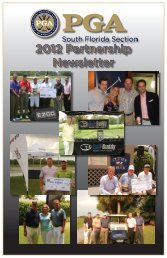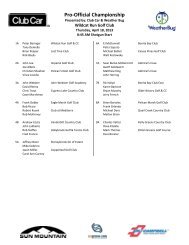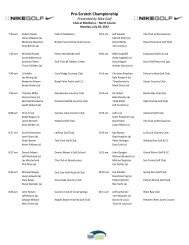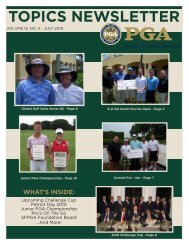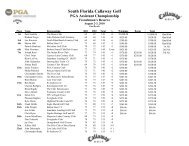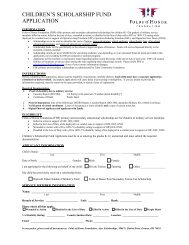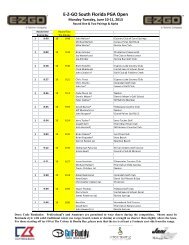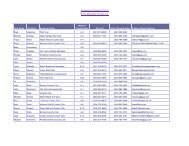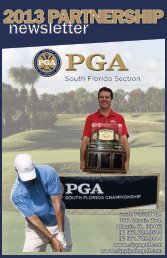TOPICS NEWSLETTER - South Florida PGA Golf
TOPICS NEWSLETTER - South Florida PGA Golf
TOPICS NEWSLETTER - South Florida PGA Golf
Create successful ePaper yourself
Turn your PDF publications into a flip-book with our unique Google optimized e-Paper software.
This past weekend I tuned into CBS’s coverage<br />
of the <strong>PGA</strong> Tour’s AT&T National event.<br />
After watching for quite some time I couldn’t<br />
figure out why there were so few spectators.<br />
For example, they showed Tiger, who usually<br />
has a sea of fans following his every step, but<br />
this day there were only a hand full of people<br />
outside the ropes. As I continued to watch,<br />
Jim Nantz made reference to the powerful storms<br />
that slashed though the Midwest that Friday night,<br />
eventually making their way to the East coast and<br />
the Washington area all while causing significant<br />
damage and power outages along the way. Unfortunately<br />
the grounds of Congressional Country<br />
Club were among those reporting significant<br />
damage in the wake of the storm. The damage<br />
to the course was so severe that it forced officials<br />
to close the event to spectators and volunteers.<br />
Longtime <strong>PGA</strong> Tour Rules official, Mark Russell said<br />
he could not remember another time when a tour<br />
event did not allow fans. “It’s too dangerous out<br />
here,” Russell said. “There’s a lot of hanging limbs.<br />
There’s a lot of debris. It’s like a tornado came<br />
through here. It’s just not safe.” As I watched the<br />
coverage, I couldn’t help but think how the playing<br />
of the game and the Rules of <strong>Golf</strong> would be affected<br />
by the outcome of this storm.<br />
Periodically the coverage shifted its focus from<br />
golf and showed the damaged left behind from this<br />
mid-summer storm. They showed many downed<br />
trees, sawed up trees, twigs, branches and other<br />
structural damage. They showed many fresh tree<br />
stumps and I wondered if they were going to grant<br />
relief from them? Decision<br />
25/8 asks, “Do the Rules provide<br />
relief without penalty for<br />
a tree stump? No, not unless<br />
it has been marked as ground<br />
under repair or it is in the<br />
process of being unearthed or<br />
cut up for removal, in which<br />
case it is “material piled for<br />
removal” and thus automatically<br />
ground under repair. A<br />
tree stump which the Committee<br />
intends to remove, but<br />
which is not in the process of<br />
being removed, is not automatically ground under repair.”<br />
There were also many trees which were cracked at the base and still<br />
attached to the stump. Does a tree still attached to the stump change<br />
how it was just classified above? Decision 23/7 asks, “Is a fallen tree<br />
a loose impediment? If it is still attached to the stump, no; if it is not<br />
attached to the stump, yes.” So if a tree were still attached to the<br />
stump, the player would not be permitted to move parts of the downed<br />
tree if they interfered with his stance or area of intended swing. To do<br />
so would be a breach of Rule 13-2. But what would be the ruling if the<br />
tree was no longer attached to the stump, thus making it a loose impediment?<br />
Decision 23-1/4 asks the question, “If part of a large branch<br />
which has fallen from a tree (and thus is a loose impediment) interferes<br />
with a player’s swing, may the player break off the interfering part<br />
rather than move the whole branch?” The answer is yes. The Rules do<br />
not force you to move the entire loose impediment. You are permitted<br />
to move just the part that interferes with your play.<br />
A little later in the telecast Jim Nantz praised the grounds grew<br />
who had worked tirelessly cleaning up the debris to make the course<br />
playable. There were piles of stacked up tree branches, leaves, sticks<br />
WEATHER THE WEATHER<br />
SF<strong>PGA</strong> TOURNAMENT DIRECTOR<br />
ANDREW MILLER<br />
and sawed up trees everywhere. How<br />
would these areas be classified under<br />
the Rules? Decision 25/7 states, “A<br />
greenkeeper is in the process of sawing<br />
up a fallen tree and stacking the wood.<br />
What is the status of such a tree? The<br />
tree in its entirety is ground under repair<br />
as it constitutes “material piled for removal.”<br />
The definition of ground under repair states<br />
that material piled for removal is ground<br />
under repair even if it hasn’t been marked<br />
as such. Thus if a players ball were to come<br />
to rest in an area where a pile of debris<br />
interfered with the lie of his ball or area of<br />
intended swing, the player would be permitted<br />
to take relief under Rule 25-1. However,<br />
if the player found his ball several yards<br />
behind the material piled for removal, thus<br />
having interference for his line of play and<br />
not for the lie of the ball or area of intended<br />
swing, the player would not be granted any<br />
free relief under Rule 25-1 since that Rule<br />
does not provide intervention relief.<br />
Mark Russell had mentioned how dangerous<br />
the grounds were following the storm with<br />
all the debris and hanging braches. We’ve<br />
already covered how a fallen tree, whether<br />
still attached to its stump or not is treated<br />
by the Rules of <strong>Golf</strong>, but what kind of special<br />
consideration would be given for a tree<br />
which falls during the stipulated round? Decision<br />
25/9.5 states, “A large tree falls onto a<br />
fairway during a stipulated<br />
round and cannot<br />
readily be removed.<br />
What should the Committee<br />
do? The most<br />
appropriate course of<br />
action will depend on<br />
the circumstances in<br />
each case. The Committee<br />
has the following<br />
options: (1) require<br />
play to continue, providing<br />
no additional relief<br />
from the fallen tree;<br />
(2) suspend play and have the tree removed; (3) declare the tree<br />
and the area covered by the tree to be ground under repair (Rule<br />
25-1) and may, as an additional option, establish a dropping zone;<br />
or (4) in equity (Rule 1-4), adopt the relief procedures under the<br />
Local Rule for Temporary Obstructions, thus providing intervention<br />
relief from the fallen tree.” I was actually quite familiar with this<br />
particular Decision since this exact situation happened at few years<br />
back during the final round of the <strong>Florida</strong> State Senior Open. We<br />
decided on option 3 above to deal with the situation however we<br />
decided not to establish any additional dropping zones.<br />
Mother nature plays a tremendous role in the sport we all love<br />
and given the fact that we can’t take the game indoors or hide<br />
behind a retractable roof, sometimes we have to take what she<br />
gives us. The gifts she left in the form of fallen trees and debris at<br />
the AT&T was neither ideal nor appreciated. A feeling especially<br />
felt from the grounds crew. However with a lot of hard work and<br />
a little help from the Rules of <strong>Golf</strong>, another successful <strong>PGA</strong> Tour<br />
event was achieved.



